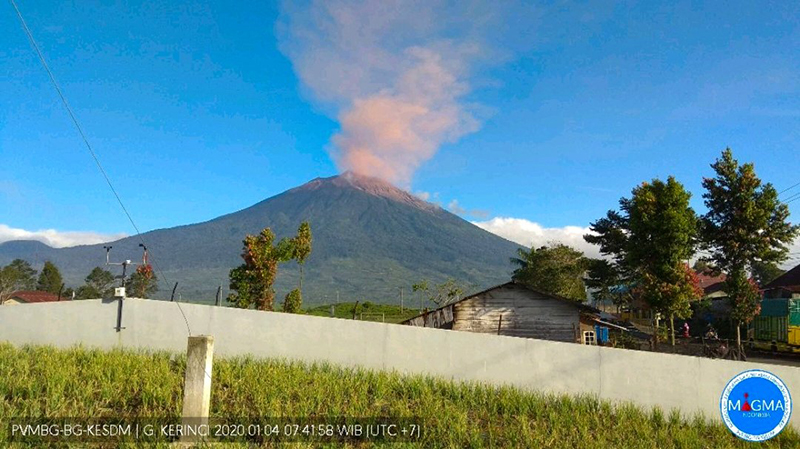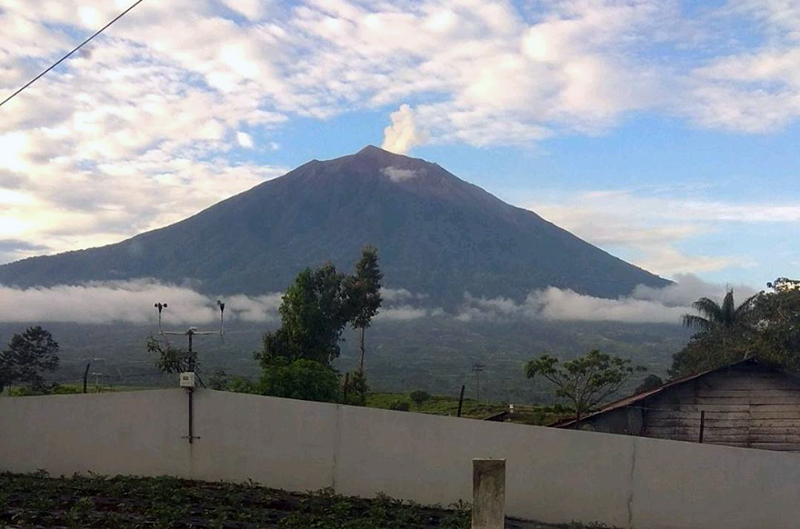Report on Kerinci (Indonesia) — July 2020
Bulletin of the Global Volcanism Network, vol. 45, no. 7 (July 2020)
Managing Editor: Edward Venzke.
Edited by Kadie L. Bennis.
Kerinci (Indonesia) Intermittent ash emissions during January-early May 2020
Please cite this report as:
Global Volcanism Program, 2020. Report on Kerinci (Indonesia) (Bennis, K.L., and Venzke, E., eds.). Bulletin of the Global Volcanism Network, 45:7. Smithsonian Institution. https://doi.org/10.5479/si.GVP.BGVN202007-261170
Kerinci
Indonesia
1.697°S, 101.264°E; summit elev. 3800 m
All times are local (unless otherwise noted)
Kerinci is a stratovolcano located in Sumatra, Indonesia that has been characterized by explosive eruptions with ash plumes and gas-and-steam emissions. The most recent eruptive episode began in April 2018 which has included intermittent explosions and ash plumes. The previous report (BGVN 44:12) described more recent activity consisting of intermittent gas-and-steam and ash plumes which occurred during June through early November 2019. This volcanism continued through May 2020, though little to no activity was reported during December 2019. The primary source of information for this report comes from Pusat Vulkanologi dan Mitigasi Bencana Geologi (PVMBG, also known as Indonesian Center for Volcanology and Geological Hazard Mitigation, CVGHM) and the Darwin Volcanic Ash Advisory Centre (VAAC).
Activity during December 2019 consisted of white gas-and-steam emissions rising 100-500 m above the summit. White and brown emissions continued intermittently through May 2020, rising to a maximum altitude of 1 km above the summit on 14 April. During 3-6 and 8-9 January 2020, the Darwin VAAC and PVMBG issued notices reporting brown volcanic ash rising 150-600 m above the summit drifting S and ESE (figure 19). PVMBG published a VONA notice on 24 January at 0828 reporting ash rising 400 m above the summit. Brown emissions continued intermittently throughout the reporting period. On 1 February, volcanic ash was observed rising 300-960 m above the summit and drifting NE; PVMBG reported continuing brown emissions during 1-3 February. During 16-17 February, two VONA notices reported that brown ash plumes rose 150-400 m above the summit and drifted SW accompanied by consistent white gas-and-steam emissions (figure 20).
 |
Figure 19. Brown ash plume rose 500-600 m above Kerinci on 4 January 2020. Courtesy of MAGMA Indonesia via Øystein Lund Andersen. |
 |
Figure 20. White gas-and-steam emissions rose 400 m above Kerinci on 19 February 2020. Courtesy of MAGMA Indonesia via Øystein Lund Andersen. |
During 1-16 and 25-26 March 2020 brown ash emissions were frequently observed rising 100-500 m above the summit drifting in multiple directions. During 6-8 and 10-15, April brown ash emissions were reported 50-1,000 m above the summit. The most recent Darwin VAAC and VONA notices were published on 14 April, reporting volcanic ash rising 400 and 600 m above the summit, respectively; however, PVMBG reported brown emissions rising up to 1,000 m. By 25-27 April brown ash emissions rose 50-300 m above the summit. Intermittent white gas-and-steam emissions continued through May. The last brown emissions seen in May were reported on the 7th rising 50-100 m above the summit.
Geological Summary. Gunung Kerinci in central Sumatra forms Indonesia's highest volcano and is one of the most active in Sumatra. It is capped by an unvegetated young summit cone that was constructed NE of an older crater remnant. There is a deep 600-m-wide summit crater often partially filled by a small crater lake that lies on the NE crater floor, opposite the SW-rim summit. The massive 13 x 25 km wide volcano towers 2400-3300 m above surrounding plains and is elongated in a N-S direction. Frequently active, Kerinci has been the source of numerous moderate explosive eruptions since its first recorded eruption in 1838.
Information Contacts: Pusat Vulkanologi dan Mitigasi Bencana Geologi (PVMBG, also known as Indonesian Center for Volcanology and Geological Hazard Mitigation, CVGHM), Jalan Diponegoro 57, Bandung 40122, Indonesia (URL: http://www.vsi.esdm.go.id/); Darwin Volcanic Ash Advisory Centre (VAAC), Bureau of Meteorology, Northern Territory Regional Office, PO Box 40050, Casuarina, NT 0811, Australia (URL: http://www.bom.gov.au/info/vaac/); MAGMA Indonesia, Kementerian Energi dan Sumber Daya Mineral (URL: https://magma.vsi.esdm.go.id/); Sentinel Hub Playground (URL: https://www.sentinel-hub.com/explore/sentinel-playground); Øystein Lund Andersen (Twitter: @OysteinLAnderse, https://twitter.com/OysteinLAnderse, URL: http://www.oysteinlundandersen.com, images at https://twitter.com/OysteinLAnderse/status/1213658331564269569/photo/1 and https://twitter.com/OysteinLAnderse/status/1230419965209018369/photo/1).

